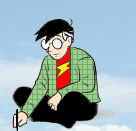More than One Way to Skin a Cat
February 9th, 2011
Having trouble with perspective? Lucky for you, David Chelsea has a great book on the subject (in comics form no less) that explains everything you need to know about drawing 3-D scenes in Flatland.
But if you still feel out of your depth with full western perspective, David points out in a recent blog post, that there’s a simpler alternative — the isometric approach — that can help create the illusion of depth by following a few simple rules.
Part One is here, with more examples in Part Two, including my photo from the CN tower with it’s Sims-like isometric composition.
Posted in Cartoonists, Process















There’s also a good one called VANISHING POINT by Jason Cheeseman-Meyer.
http://www.amazon.com/Vanishing-Point-Perspective-Comics-Ground/dp/1581809549
I recently picked up Jason’s book over David’s because it’s supposed to cover a bit more ground (mainly curvilinear perspective). I definitely find the comic strip presentation of David’s book more appealing though.
I have Jason’s book as well, partially* because the local Borders AND Barnes & Noble have no capacity to get or keep David’s book in stock. It’s not bad at all, and certainly easier to digest than some of the more “vintage” books on the subject I’ve collected.
*also, was heading to B&N anyway to get Framed Ink
http://www.amazon.com/Framed-Ink-Drawing-Composition-Storytellers/dp/1933492953/
I guess you heard my sighs – I’m just working on a 3 point perspective with objects that are slightly rotated around their z-axis… Do you know a good software tool for making perspective grids? And by the way: thanks for your books, I likes them very much…
I always used Adobe Illustrator to make grids, though I’d think any object-oriented drawing program would do.
photoshops new vanishing point tool can be really handy haven’t messed around with it enough yet but it’s great
This rocks with a pretty fair intensity!
Ha, small world! Chelsea’s book arrived in Saturday’s mail and I just went through it for the second time. I understand his explanations for the most part but it’s great having additional alternatives. Thanks!
As I get older and long for more of that human touch in my art, I find that I much prefer an imperfectly hand drawn setting than a tight digitally assisted landscape. Warts and all, the warbly backdrops tend to stand out against all those perfect renditions.
Hi Scott! I just finishing reading “Making Comics” and just want to say “thank you!” for making the daunting and amazing world of comics a little more accesible. 😀 Can’t wait to keep up with you on your blog!
Hey Scott, Its interesting how I landed up on your site – but I found your ‘Google Chrome comic’ very fascinating. I am somewhat of an artist and no much of a cartoonist, but amazingly I can easily draw 3-D scenes and drawings. I’ve no problem visualizing objects, turning and rotating them in my head, and even copying the various positions onto paper. Do you think I got a special talent :)) By the way, I did learn a bit about ‘Engineering Drawing’ way back in college, and maybe those concepts got deeply embedded in my head. There I recommend those books and practices for those who want to master the isometric art. Great site, great work. I envy you 😉 😀
This is why I check this site every day. I keep a daily book and there’s often an excellent surprise exercise waiting for me here. A few entries back, your offhand mention that it was Hourly Comics Day led into me doing an hourly comic that day. This entry made me realize; I’ve never drawn in isometric perspective before. So I did. And it was cool!
For the 2 years I worked at the XPLANE consultancy, I drew god knows how many environments and scenes and systems, all in isometric – so that final vector art elements could be picked up and moved around in the image without any redrawing, and so characters or objects were rarely obscured by foreground stuff jutting in front of them.
At this point I can do it without any guidelines at all. It’s a very soothing and intuitive perspective to draw in, especially if you want to depict, say, the floorplan of an entire grocery store and your characters navigating their way through it, or what’s happening in every part of a crowded ballroom.
It does trap the reader into seeing everything from the POV of Ceiling Cat, though.